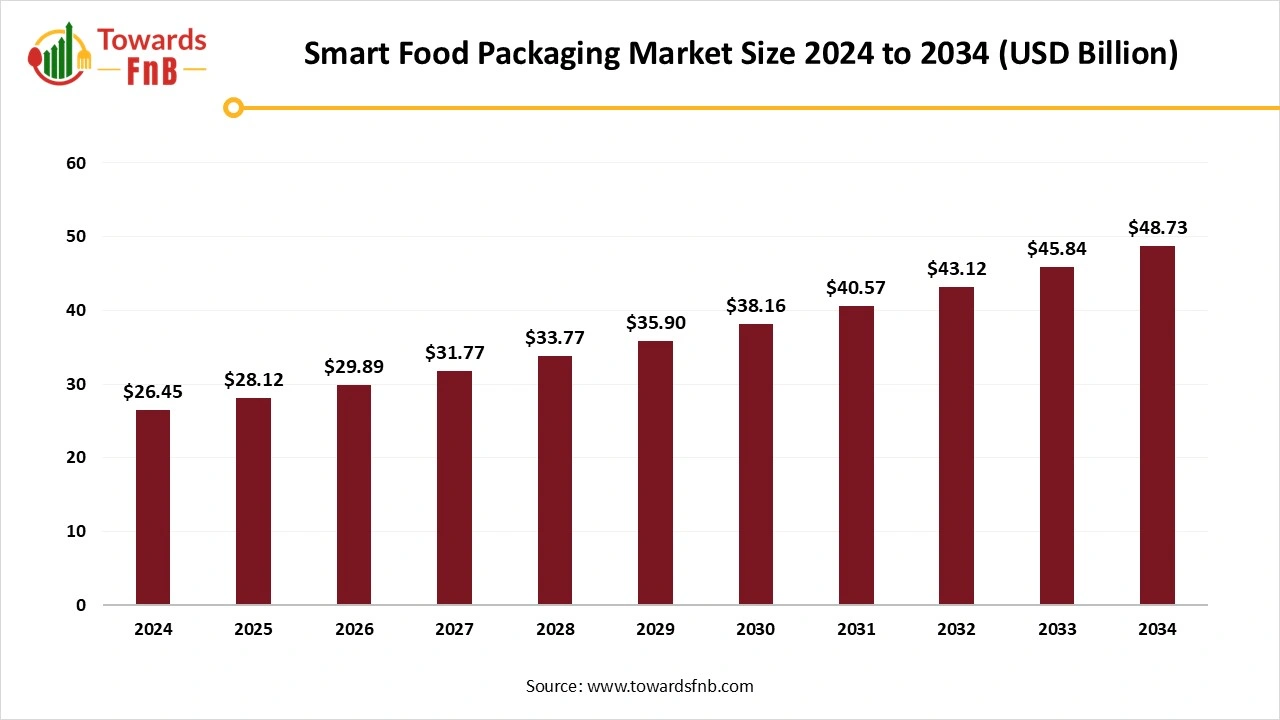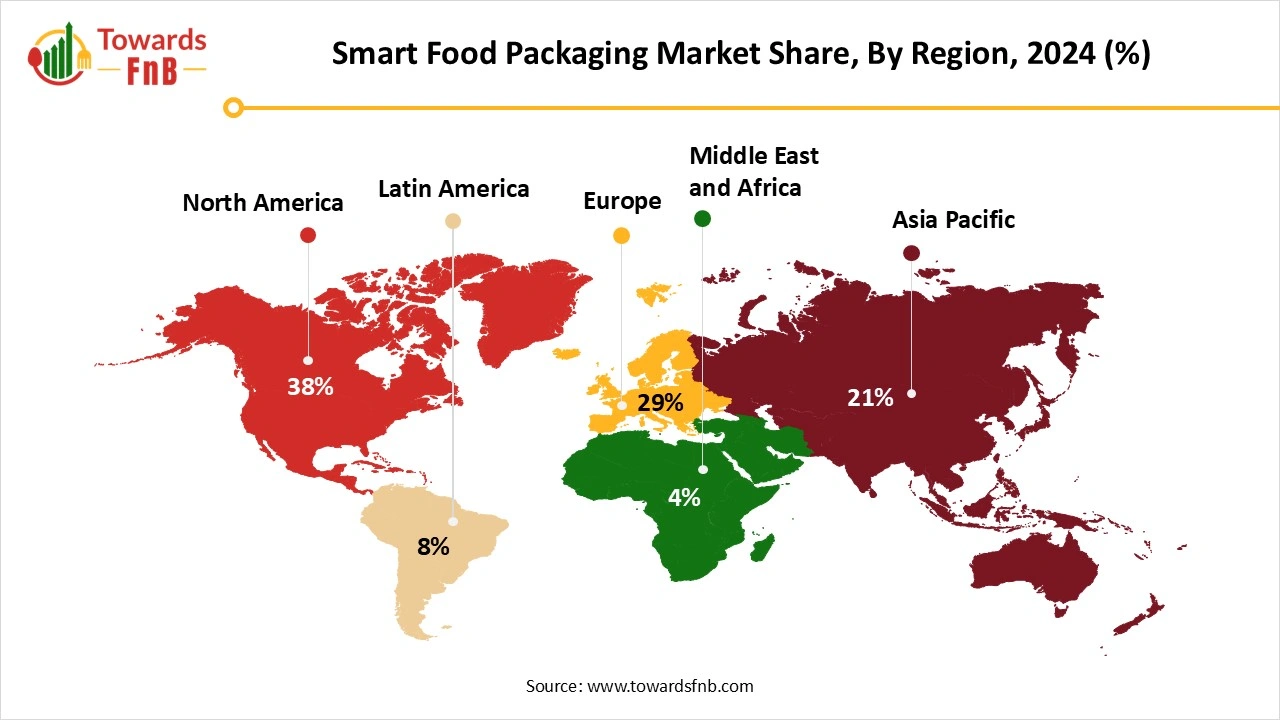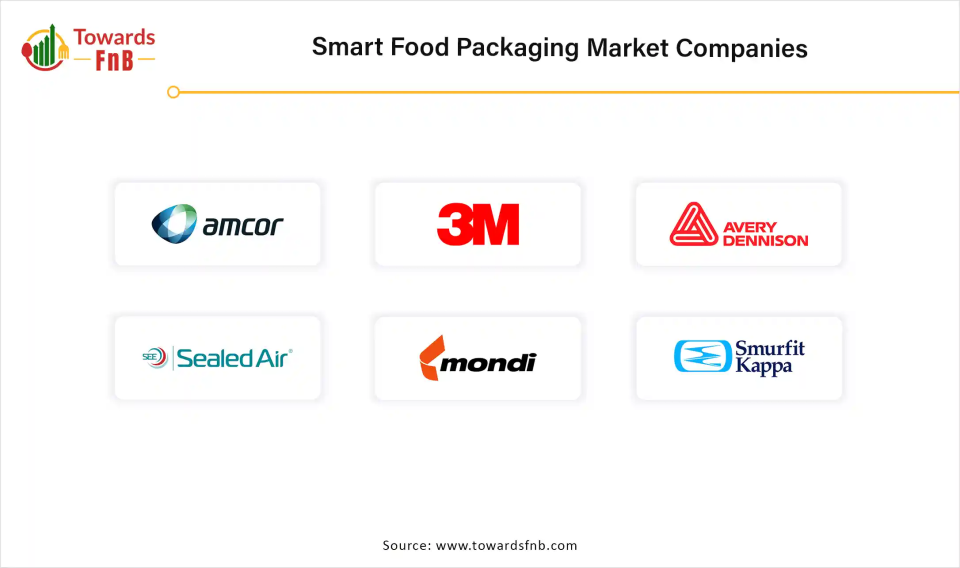December 2025
The global smart food packaging market size was valued at USD 26.45 billion in 2024 and is expected to grow steadily from USD 28.12 billion in 2025 to reach nearly USD 48.73 billion by 2034, with a CAGR of 6.3% during the forecast period from 2025 to 2034. Increasing demand for the food safety, enhanced shelf life and demand for sustainability driving the market.

| Study Coverage | Details |
| Growth Rate from 2025 to 2034 | CAGR of 6.3% |
| Market Size in 2025 | USD 28.12 Billion |
| Market Size in 2026 | USD 29.89 Billion |
| Market Size by 2034 | USD 48.73 Billion |
| Largest Market | North America |
| Base Year | 2024 |
| Forecast Period | 2025 to 2034 |
| Regions Covered | North America, Europe, Asia-Pacific, Latin America, and Middle East & Africa |
The smart food packaging market refers to advanced packaging systems that monitor, sense, and sometimes respond to internal or external conditions of packaged food to ensure quality, extend shelf life, enhance safety, provide real-time information, and improve consumer engagement. Smart packaging includes active packaging (interacts with the product to maintain or improve freshness) and intelligent packaging (monitors and communicates the condition of the food or environment). These solutions combine materials science, sensors, and digital technologies (like QR codes, RFID, and IoT) to address rising concerns about food safety, waste reduction, traceability, and sustainable consumption.
Through AI, brands can develop packaging that appears customized and personal for the consumer by examining consumer data. AI improves customer experience by creating limited-edition packaging for special occasions or incorporating QR codes that deliver tailored content, achieving what was once unattainable. AI provides endless possibilities to enhance and transform the packaging experience. Using AI, businesses can respond more swiftly, strengthen relationships with customers, and establish themselves as frontrunners in their industry.
The substantial expenses linked to advanced packaging options pose a major obstacle to the integration of smart food packaging technologies. Solutions combining sensors, RFID, and blockchain technology for tracking and monitoring product conditions typically demand advanced materials and intricate manufacturing processes. This leads to a significant rise in production expenses when compared to conventional packaging techniques. This financial strain is especially difficult for small and medium-sized manufacturers.
North America Dominated the Smart Food Packaging Market in 2024.
In 2023, around 331 million individuals live in North America, with a growing population residing in cities known for their rapid lifestyles. This change in demographics has resulted in a rise in the demand for packaged foods, especially convenience meals. The increasing dependence on packaged items is intensified by the emergence of foodservice providers and digital platforms that streamline food ordering, ultimately improving the availability of these meals. As a result, producers must invest in packaging technologies that preserve the integrity and quality of food while in transit, ultimately fostering market growth. Sustainability efforts are profoundly changing the food packaging industry, propelled by increased consumer consciousness regarding environmental concerns.

Multiple essential elements drive demand in the US smart food packaging sector. Reducing food waste is a key motivator. Intelligent packaging assists in tracking freshness, notifying consumers of possible spoilage and facilitating prompt consumption. This reduces the waste of consumable food, lowers ecological effects, and saves money for consumers and producers alike. In addition to minimizing waste, safety issues are also a factor. Intelligent packaging can identify harmful bacteria, changes in temperature, or tampering efforts, improving food safety and minimizing the likelihood of foodborne diseases. This safeguards consumers' well-being and fosters confidence in food brands. The swift expansion of e-commerce and online food delivery services significantly increases the need for specialized food packaging. The need for packaging that is more durable, leak-resistant, and thermally insulated quickly rose alongside the surge in online grocery and prepared meal orders, which serves as a factor driving growth.
Asia Pacific Expects Significant Growth During the Forecast Period.
Main factors influencing the smart food packaging market in the Asia Pacific include growing consumer demand for sustainable products and rising regulatory pressures to diminish plastic waste. The expanding food and beverage industry requires packaging that maintains freshness and safety while reducing environmental harm. The rise of urbanization and growing e-commerce food delivery enhances the need for smart packaging that provides longer shelf life and better monitoring. Regional food safety issues, along with traceability needs, promote the use of RFID and QR codes featuring time-temperature indicators across different markets. This trend has resulted in increased awareness about the environment regarding a decrease in greenhouse emissions. The Asia Pacific region is experiencing a significant demand for processed and ready-to-eat foods, driving the need for innovative packaging technologies that guarantee freshness and quality.
The market is propelled by growing consumer needs for food safety and freshness, coupled with heightened health consciousness, prompting the use of smart packaging technologies in India that facilitate real-time quality monitoring through spoilage, temperature, and contamination checks, thus boosting confidence in packaged food in urban and semi-urban areas. The move towards sustainable packaging options is significantly impacting India's smart food packaging industry. With increasing environmental awareness among both consumers and regulators, the demand for smart packaging solutions that are biodegradable, recyclable, or derived from renewable resources is on the rise. Brands are now integrating sustainability with smart features, like freshness indicators and quick response codes, while still upholding environmental objectives. This trend is being strengthened by government initiatives encouraging plastic waste reduction and extended producer responsibility.
How Active Packaging Segment Dominated the Smart Food Packaging Market in 2024?
Active packaging segment dominated the smart food packaging market in 2024. This increase is attributed to its recognized attributes in maintaining the freshness, taste, and nutritional quality of food and drinks, ensuring that products arrive to consumers with the intended quality. Active packaging technologies like moisture scavengers absorb excess moisture from packages to maintain optimal humidity levels, thereby prolonging the shelf life of packaged foods by reducing conditions that lead to degradation and mold development, preserving the quality of moisture-sensitive foods, and consequently hindering microbial growth and spoilage of the products.
Intelligent Packaging Segment is Observed to Grow at the Fastest Rate During the Forecast Period.
The intelligent food Packaging is a fast-changing industry that incorporates cutting-edge technologies like radio frequency identification, sensors, and data-based systems into food packaging solutions. These advancements assist in tracking the freshness, safety, and quality of food items. This market has gained popularity because of rising consumer demand for convenience, sustainability, and enhanced food safety. Technologies like AI-powered sensors, interactive NFC tags, and blockchain authentication tools have been incorporated to enhance transparency and minimize counterfeiting threats.
Which Material Type Segment Held the Dominating Share of the Smart Food Packaging Market in 2024?
Plastics (PET, PE, PP) segment held the dominating share of the smart food packaging market in 2024. This optimistic perspective stems from its remarkable flexibility, durability, and lightweight characteristics. They are commonly employed for packaging various food items, including both liquids and solids, because they offer outstanding barrier qualities that safeguard contents against contamination, moisture, and oxygen. Furthermore, the increasing innovation of bio-based plastics like bio-based PE, PP, and PET and their application in creating bags and pouches is boosting the segment's development.
Biodegradable Materials & Smart Films Segment is Seen to Grow at a Notable Rate During the Predicted Timeframe.
Driven by heightened environmental consciousness, rising consumer demand for sustainable choices, and progress in material science. Intelligent polymer films and coatings are essential for improving the longevity and safety of food items. They can offer a shield against environmental elements like moisture, oxygen, light, and pollutants. Furthermore, they may provide features like antimicrobial capabilities, oxygen absorption, and freshness indicators.
What Shelf-Life Extension the Dominant Segment of the Smart Food Packaging Market in 2024?
Shelf-life extension segment dominated the market with the largest share in 2024. Shelf-life extension is a key use in the smart food packaging industry as it directly meets consumer needs for safer, longer-lasting food and minimizes food waste. Active and intelligent packaging technologies can greatly enhance the shelf life of perishable items, reduce waste, and boost food safety, appealing to both consumers and companies. Intelligent packaging options such as ethylene absorbers and 1-MCP (1-Methylcyclopropene) can prevent ripening and spoilage, especially in fruit and vegetables, which is essential for preserving freshness and quality during storage and transport.
Spoilage Detection & Traceability Segment is Expected to Grow at the Fastest Rate in the Smart Food Packaging Market During the Forecast Period.
Driven by rising consumer demand for safety, convenience, and sustainability, alongside the necessity for improved supply chain management. These technologies assist in lowering food waste, decreasing foodborne diseases, and offering important details regarding product origin and status. RFID and various technologies facilitate the monitoring of products along the supply chain, which permits quicker identification of the origins of any contamination or spoilage problems.
Why did the Meat, Poultry & Seafood Segment Dominate in 2024?
Meat, poultry & seafood segment held the largest share of the smart food packaging market in 2024, due to the essential demand for longer shelf life, better safety, and improved traceability for these perishable items. Increasing worldwide appetite for meat, poultry, and seafood, especially in emerging nations, drives the necessity for innovative packaging solutions. The growth of processed and frozen meat items, along with sustainability initiatives in packaging, is transforming market dynamics in this sector. Increasing interest in protein-loaded diets and the surge in online food sales are speeding up acceptance.
Fruits & Vegetables Segment is Observed to Grow at the Fastest Rate During the Forecast Period.
Fresh produce, crucial for a nutritious diet, is prone to deterioration from moisture loss, enzyme action, and microbial infection due to which demand for the smart packaging is rising. With the increasing consumer appetite for fresh produce, the need for innovative preservation methods that guarantee food safety and reduce waste is becoming increasingly clear. Intelligent packaging provides a possible answer by prolonging shelf life and minimizing waste in the supply chain.
How Food Manufacturers Segment Dominated the Smart Food Packaging Market in 2024?
Food manufacturers segment dominated the market in 2024. The growing western influence and hectic lifestyles globally have resulted in a rise in the popularity of convenient foods and drinks. The trend provides consumers with convenience and portability, along with an extended product shelf life. The items need advanced and durable packaging materials to last for an extended period. Rising demand for packaged meals and heightened dairy products consumption are fueling the expansion of the worldwide market. The rising trend in the consumption of freshly packaged food is also contributing to market growth.
E-Commerce & D2C Food Brands Segment is Seen to Grow at a Notable Rate During the Predicted Timeframe.
With the rise of online shopping, intelligent packaging is emerging as a key asset for D2C companies to set their products apart, cultivate customer loyalty, and establish lasting connections with tech-oriented consumers. The expansion of e-commerce heightens the demand for real-time monitoring, secure shipments, and damage mitigation, which smart packaging meets with features such as tamper-proof seals and condition-monitoring devices. Intelligent packaging that incorporates technologies such as QR codes, sensors, and interactive features tackles major issues in online food sales, including maintaining product quality during shipping and offering comprehensive product details.
Mondelēz International
Superplum

By Technology Type
By Material Type
By Functionality
By Application
By End-User
By Region
December 2025
December 2025
December 2025
December 2025